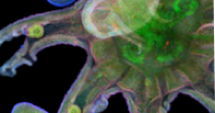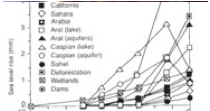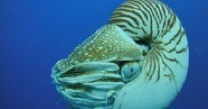In the Jacobs Lab we study the coevolution of Earth and Life. Our approaches are synthetic and involve a wide range of questions and different combinations of data and analysis to answer them.
One suite of questions involves how deep-time environments influenced the initial evolution of complexity in eukaryotes and multi-cellular organisms as well as the subsequent diversity of life. These questions range in scale from the development of individual fossil forms and the modeling of processes associated with particular paleo-communities, to global scale impacts on diversity. Some of these questions are addressed with data from the fossil record. However, questions relating to evolution of cellular and development complexity centered around the Cambrian radiation are approached with a wide variety of molecular techniques.
Another suite of questions involves more recent geologic, climate and anthropogenic processes and how they influence coastal speciation and conservation. Here, we study how tectonic and sea-level processes form coasts, how coastal processes form habitat, and how these factors influence genetic differentiation and speciation. Here, again we employ a range of molecular tools. We then also apply historical ecology to better understand human impacts, their relationship to the past behavior of the system, and their implications for future climate and sea-level change. Study areas include the coasts of California and the Gulf of California as well as Polynesia. This coastal work has fundamental and applied aspects. It addresses basic understanding of coast formation processes and there impacts on biological evolution and diversity of coastal species. This then leads to management implications relative to the restoration of coastal habitat, and the management of endangered species.
Evolution of coastal taxa and underlying geologic mechanisms.Evolutionary History - Conservation Genetics - Historical Ecology- Coastal Process - Lagoons - Endangered Species
Geology and past climate change played important roles in shaping the evolution of organisms on the Pacific coast. Southern California, Baja California and the Gulf of California are hotspots for endemism and provide a prime opportunity to study this interplay.
We use a variety of sequencing techniques and analytical approaches, to examine the role of geology, climate and historic process in the genetic differentiation of species in the streams, coasts, rivers estuaries and lagoons of our region. These include studies that involve ancient DNA of extinct species, as well as studies of the genetics using museum samples. Recent publications involve: Anthropogenic effects in the Colorado Delta. The role of glacial sea level in isolating estuary species; and coastal and stream processes associated with the subdivision of the endangered Tidewater Goby, and Unarmored Three-spined Stickleback. For relevant paper, the reprints section. |
Evo-Devo and the Origins of AnimalsJellyfish genomics - Sensory organ evolution - Rangeomorphs -Ediacara- Cnidaria -Jellyfish- Neoproterozoic
Evolutionary Development (Evo Devo): Nervous and sensory structures of jellyfishJellyfish are members of the Cnidaria, a phylum that is the sister group to 99% of all animals alive today. Despite their deep ancestry with more complex animals, jellyfish share many homologous genes. We are focusing on genes that are deployed in the development of nervous and sensory systems in other animals, to see if they are used in a conserved manner in the jellyfish Aurelia sp.1
For relevant papers, see Jacobs et al (2007), Nakanishi et al (2008), Yuan et al (2008), Nakanishi et al (2009), Nakanishi et al (2010), Jacobs et al (2010), and Gold and Jacobs (2013) in the reprints section. |
© 2014 David K. Jacobs. All Rights Reserved. All images are taken from personal collections or from Wikimedia commons.



